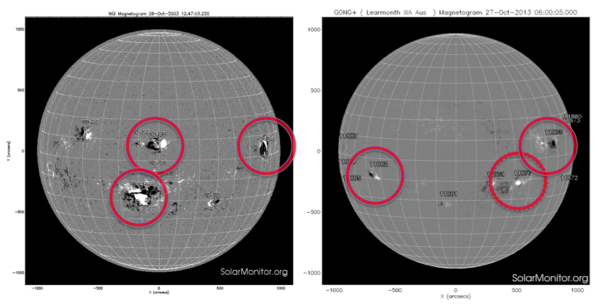The Halloween Flares and Large-Scale Correlations
From RHESSI Wiki
| Nugget | |
|---|---|
| Number: | |
| 1st Author: | Richard Schwartz |
| 2nd Author: | Hugh Hudson |
| Published: | October 28, 2013 |
| Next Nugget: | TBD |
| Previous Nugget: | Scattering Polarization in Solar Flares |
| List all | |
Introduction
The celebrated phenomena of the "Halloween Flares" of 2003 have reappeared, more weakly, in October 2003. In the waning phase of the previous sunspot maximum, a remarkable group of apparently independent sunspot groups appeared within a few days of one another. Something like this has just happened, or is just happening, in the declining phase of our current sunspot maximum ([Cycle 24]). For reasons unknown in detail, and probably unknowable any time soon, the organization of solar activity visible at the surface has large-scale correlations in space and time, meaning that flares bunch up in a highly non-random manner:
October flares Year Class M Class X MX regions 2003 37 7 5 2013 25 2 6
From this little table one can see that the 2003 case had an even more extraordinary concentration of major flares in a small (but multiple) number of active regions.
Time scales and Correlations
In our conventional view of the sources of flare energy, we turn to the magnetic field in the corona. But it is the low corona, in active regions, that contains the bulk of the energy, and this appears above the photosphere only when flux emerges from the interior. Now we need to consider characteristic scales of space and time on the Sun. In the photosphere, the convective motions are organized into granulation and supergranulation, the latter also the source of the chromospheric network. The time/distance scales for these features are roughly 10 min/1000 km and 1 day/30,000 km respectively.
Now consider the occurrence pattern of the Halloween flares of 2003 and 2013, as illustrated in Figure 1. The major flares occur in each case on spatial and temporal scales quite inconsistent with what we see in the photosphere. Therefore it seems likely that some slowly-developing, large-scale structure in the deep interior - the legendary [solar dynamo] process - must be responsible.

| RHESSI Nugget Date | 28 October 2013 + |
| RHESSI Nugget First Author | Richard Schwartz + |
| RHESSI Nugget Second Author | Hugh Hudson + |